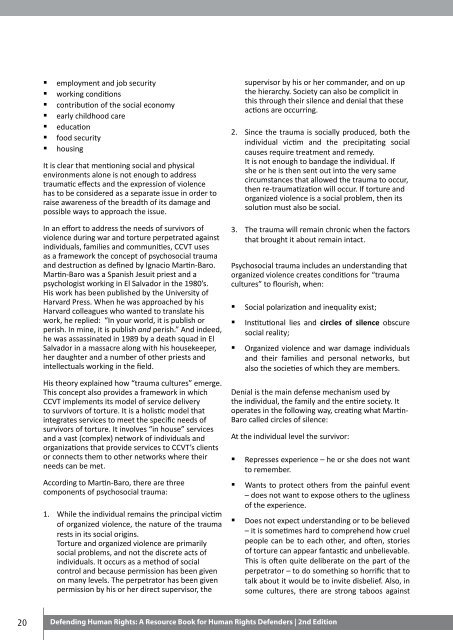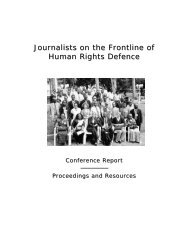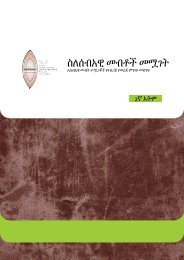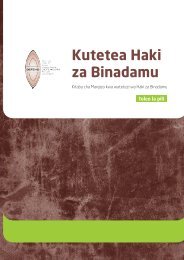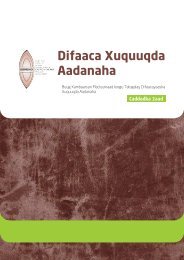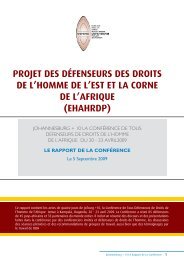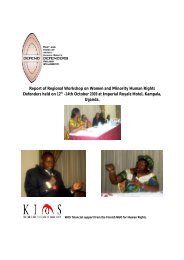Defending Human Rights: A Resource Book for Human
Defending Human Rights: A Resource Book for Human
Defending Human Rights: A Resource Book for Human
You also want an ePaper? Increase the reach of your titles
YUMPU automatically turns print PDFs into web optimized ePapers that Google loves.
• employment and job security<br />
• working conditions<br />
• contribution of the social economy<br />
• early childhood care<br />
• education<br />
• food security<br />
• housing<br />
It is clear that mentioning social and physical<br />
environments alone is not enough to address<br />
traumatic effects and the expression of violence<br />
has to be considered as a separate issue in order to<br />
raise awareness of the breadth of its damage and<br />
possible ways to approach the issue.<br />
In an ef<strong>for</strong>t to address the needs of survivors of<br />
violence during war and torture perpetrated against<br />
individuals, families and communities, CCVT uses<br />
as a framework the concept of psychosocial trauma<br />
and destruction as defined by Ignacio Martin-Baro.<br />
Martin-Baro was a Spanish Jesuit priest and a<br />
psychologist working in El Salvador in the 1980’s.<br />
His work has been published by the University of<br />
Harvard Press. When he was approached by his<br />
Harvard colleagues who wanted to translate his<br />
work, he replied: “In your world, it is publish or<br />
perish. In mine, it is publish and perish.” And indeed,<br />
he was assassinated in 1989 by a death squad in El<br />
Salvador in a massacre along with his housekeeper,<br />
her daughter and a number of other priests and<br />
intellectuals working in the field.<br />
His theory explained how “trauma cultures” emerge.<br />
This concept also provides a framework in which<br />
CCVT implements its model of service delivery<br />
to survivors of torture. It is a holistic model that<br />
integrates services to meet the specific needs of<br />
survivors of torture. It involves “in house” services<br />
and a vast (complex) network of individuals and<br />
organizations that provide services to CCVT’s clients<br />
or connects them to other networks where their<br />
needs can be met.<br />
According to Martin-Baro, there are three<br />
components of psychosocial trauma:<br />
1. While the individual remains the principal victim<br />
of organized violence, the nature of the trauma<br />
rests in its social origins.<br />
Torture and organized violence are primarily<br />
social problems, and not the discrete acts of<br />
individuals. It occurs as a method of social<br />
control and because permission has been given<br />
on many levels. The perpetrator has been given<br />
permission by his or her direct supervisor, the<br />
supervisor by his or her commander, and on up<br />
the hierarchy. Society can also be complicit in<br />
this through their silence and denial that these<br />
actions are occurring.<br />
2. Since the trauma is socially produced, both the<br />
individual victim and the precipitating social<br />
causes require treatment and remedy.<br />
It is not enough to bandage the individual. If<br />
she or he is then sent out into the very same<br />
circumstances that allowed the trauma to occur,<br />
then re-traumatization will occur. If torture and<br />
organized violence is a social problem, then its<br />
solution must also be social.<br />
3. The trauma will remain chronic when the factors<br />
that brought it about remain intact.<br />
Psychosocial trauma includes an understanding that<br />
organized violence creates conditions <strong>for</strong> “trauma<br />
cultures” to flourish, when:<br />
• Social polarization and inequality exist;<br />
• Institutional lies and circles of silence obscure<br />
social reality;<br />
• Organized violence and war damage individuals<br />
and their families and personal networks, but<br />
also the societies of which they are members.<br />
Denial is the main defense mechanism used by<br />
the individual, the family and the entire society. It<br />
operates in the following way, creating what Martin-<br />
Baro called circles of silence:<br />
At the individual level the survivor:<br />
• Represses experience – he or she does not want<br />
to remember.<br />
• Wants to protect others from the painful event<br />
– does not want to expose others to the ugliness<br />
of the experience.<br />
• Does not expect understanding or to be believed<br />
– it is sometimes hard to comprehend how cruel<br />
people can be to each other, and often, stories<br />
of torture can appear fantastic and unbelievable.<br />
This is often quite deliberate on the part of the<br />
perpetrator – to do something so horrific that to<br />
talk about it would be to invite disbelief. Also, in<br />
some cultures, there are strong taboos against<br />
20<br />
<strong>Defending</strong> <strong>Human</strong> <strong>Rights</strong>: A <strong>Resource</strong> <strong>Book</strong> <strong>for</strong> <strong>Human</strong> <strong>Rights</strong> Defenders | 2nd Edition


